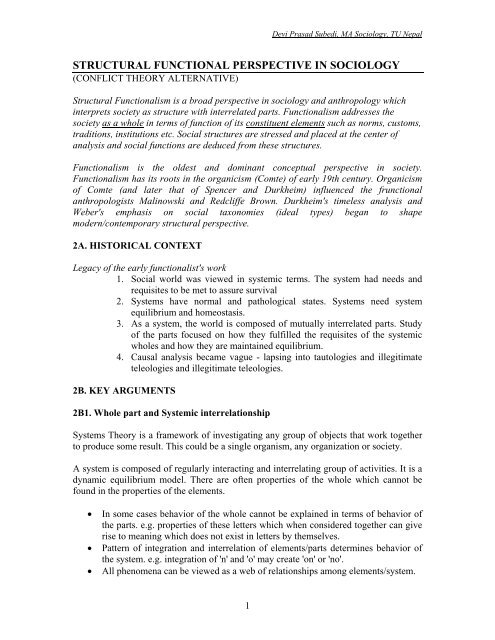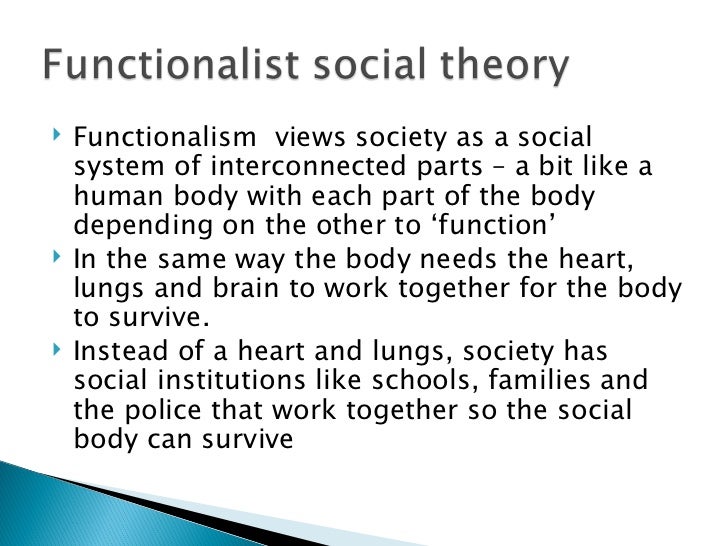Imagine a bustling city with its intricate network of roads, buildings, and people. Each part, from the traffic signals to the local bakeries, seems to operate independently yet contributes to the city’s overall functioning. This is a simple analogy for understanding the functional perspective in sociology, a lens through which we analyze society as a complex system where every element plays a vital role in maintaining order and stability.

Image: www.yumpu.com
From the mundane to the monumental, this perspective helps us understand the interconnectedness of various social institutions and their impact on the larger societal fabric. Let’s dive deeper into the fascinating world of the functional perspective, exploring its origins, core principles, and relevance in today’s ever-evolving world.
The Foundations of Functional Perspective: A Brief History
From Durkheim to Parsons: The Birth of a Paradigm
The functional perspective, also known as functionalism, traces its roots back to the sociological work of Emile Durkheim, a pioneering French sociologist in the late 19th century. Durkheim believed that society is a complex organism where each part contributes to the overall stability and functioning. He emphasized the concept of “social facts,” observable patterns of behavior that influence individual actions.
Building upon Durkheim’s foundational theories, Talcott Parsons, an influential American sociologist in the mid-20th century, further formalized the functional perspective. He argued that social systems are comprised of interconnected parts, each with its specific function or role. Parsons emphasized the importance of social institutions like family, education, and religion in maintaining equilibrium and social order.
Understanding Functionalism: Key Principles and Concepts
The functional perspective rests on several core principles, which provide a framework for analyzing social phenomena:
- Social System: Society is viewed as a complex interconnected system, where all parts, including institutions, norms, values, and individuals, work together to ensure stability and order.
- Function: Each part of the social system performs a specific function, contributing to the overall well-being and survival of the system.
- Equilibrium: The social system strives for a state of equilibrium or balance, where all parts function harmoniously to maintain stability.
- Interdependence: All parts of the system are interdependent, meaning they rely on each other for their functioning and survival.
- Manifest and Latent Functions: Actions and behaviors can have both intended (manifest) and unintended (latent) consequences. For example, the manifest function of education is to impart knowledge and skills, while a latent function could be socialization and the development of social networks.

Image: skditta.com
Examples of the Functional Perspective in Action
The functional perspective provides a valuable lens for understanding social phenomena like the role of education, religion, and the family in society. For example:
Education: Transmitting Knowledge and Promoting Social Mobility
From a functionalist perspective, education serves several crucial functions:
– It transmits knowledge and skills essential for social progress and economic development.
– It provides a pathway for social mobility, enabling individuals to advance their social standing through education and training.
– It instills values and norms, promoting social cohesion and shared beliefs.
Religion: Providing Moral Guidance and Social Cohesion
Religion, according to functionalism, plays a significant role in maintaining social order and providing moral guidance.
– It provides a framework for ethical behavior, reinforcing norms and values that contribute to societal stability.
– It serves as a source of comfort and support in times of uncertainty and hardship.
– Religious institutions often function as community centers, fostering social bonds and a sense of shared identity.
Family: The Foundation of Social Order
The family, in functionalist theory, is seen as the cornerstone of society, performing several vital functions:
– Providing primary socialization, teaching children basic societal norms and values.
– Offering emotional support and a sense of belonging for its members.
– Regulating sexual behavior and ensuring the continuation of society through procreation.
Criticism and Evolution of the Functional Perspective
While the functional perspective offers a valuable framework for understanding social order and stability, it has also faced criticism:
– **Overemphasis on Conformity:** Critics argue that the functional perspective emphasizes conformity and social order at the expense of individual agency and dissent.
– **Conservative Bias:** The focus on stability and equilibrium has been criticized as being inherently conservative, potentially downplaying social inequalities and power imbalances within society.
– **Ignoring Conflict:** Functionalism often overlooks social conflict and power struggles, which can play a significant role in shaping societal dynamics.
Despite these criticisms, the functional perspective has evolved over time, incorporating insights from other schools of thought. For example, the concept of “dysfunction” has been introduced to acknowledge that social institutions can sometimes have negative consequences. Additionally, contemporary functionalists recognize the influence of power dynamics and social change on the stability of social systems.
Modern Applications of the Functional Perspective
The functional perspective remains highly relevant in understanding contemporary social issues:
Understanding Social Change and Disruptions:
This framework can help us analyze how social change, technological advancements, and political upheavals affect the equilibrium and functioning of social systems. For example, the rise of social media has undeniably disrupted traditional communication patterns and social interactions. Analyzing this phenomenon through the functional perspective can shed light on its potential consequences for social order and stability.
Exploring Global Interdependence and Integration:
With increased globalization and interconnectedness, the functional perspective can be valuable for examining the interconnectedness of societies around the world. For instance, how do international trade and migration impact the functioning of national economies and social systems? This approach helps us better understand the complex web of relationships between nations and their potential consequences.
Tips for Applying Functional Perspective in Your Everyday life
Think about your community, workplace, or even your family as a complex social system. Consider these tips:
- Analyze the Different Parts: Identify the various institutions, groups, and individuals involved and their specific roles and functions.
- Look for Interdependence: How do these parts rely on each other? What happens if one part is disrupted?
- Analyze Manifest and Latent Functions: Observe both the intended and unintended consequences of actions and behaviors within the system. This will give you a more nuanced understanding of its dynamics.
- Identify Potential Dysfunctions: Are there any parts of the system that are not fulfilling their functions properly, potentially leading to instability or conflict?
By applying the functional perspective in your everyday life, you can gain a deeper understanding of how social systems work and the factors that contribute to their stability or disruption. This awareness can empower you to be a more informed and engaged citizen, contributing to positive change within your own community and the world at large.
FAQs on Functional Perspective
Q: What is the main advantage of using the functional perspective?
A: It provides a comprehensive framework for understanding social order and stability, highlighting the interconnectedness of different social institutions and their roles in maintaining societal equilibrium.
Q: What are some limitations of the functional perspective?
A: It tends to overlook social conflict and inequalities, potentially oversimplifying complex social dynamics. It can also be criticized for its focus on conformity and its conservative bias towards social change.
Q: How is the functional perspective still relevant today?
A: It remains relevant for analyzing social change, globalization, and the interactions between different social institutions and groups. It also offers valuable insights into the diverse functions of social institutions in modern society.
Q: Can the functional perspective be used to explain social problems?
A: Yes, by identifying dysfunctions within social institutions, the functional perspective can help us understand the root causes of social problems. It also provides a framework for analyzing potential solutions to these issues.
Functional Perspective In Sociology
Conclusion
The functional perspective in sociology is a valuable lens for understanding how social institutions work together to create stability. From analyzing the role of education in promoting social mobility to recognizing the significance of family in shaping individual identities, this perspective provides a framework for comprehending the intricate workings of society. While it’s important to acknowledge limitations and incorporate insights from other schools of thought, the functional perspective remains a useful tool for comprehending the ongoing dynamics of social systems.
Are you interested in exploring the functional perspective further? Are there any specific examples or applications of this framework that you would like to discuss?






